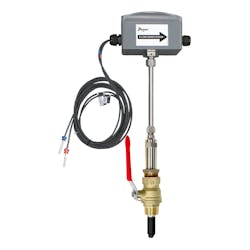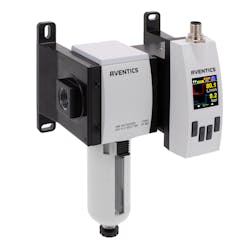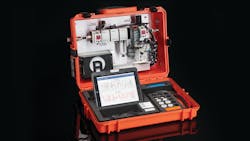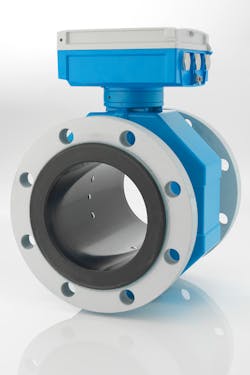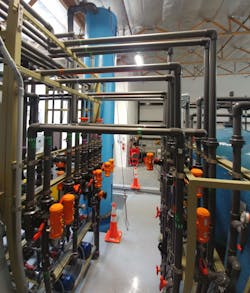Announcing the 2020 Flow Control Innovation Awards winner and honorable mentions
For more than 20 years, Flow Control’s annual Innovation Awards program has recognized the latest solutions in fluid and gas handling applications. The program accepts nominations from companies that would like to submit their technology breakthroughs in process instrumentation, and the winners are determined by a reader voting process.
We would like to thank everyone who participated in the awards program by nominating or voting. And, congratulations to the winner and honorees. We hope to see your solution nominated next year.
Watch this video to learn more about the 2020 Innovation Awards winner:
The following case studies highlight the technology solutions from the 2020 Innovation Awards winner and honorable mentions.
Winner: FLUXUS STFLEXIM AMERICAS Corporation
Nonintrusive steam meter improves accuracy and reliability of steam measurement
Steam is a commodity and necessity for many industries in the world. Whether it is used for heating a building or as a heating source for an industrial application such as heating a vessel, the measurement of steam is essential. Clamp-on flow measurement for liquids with the transit-time principle has been around for over 40 years. Fifteen years ago, nonintrusive gas flow measurement was introduced, but measuring steam with clamp-on ultrasonics remained elusive. For ultrasonic meters, dry saturated steam is like a gas except the temperatures are much higher.
FLEXIM’s Clamp-On Ultrasonic Steam Meter is available in both permanent and portable versions. FLEXIM offers excellent low flow sensitivity — an aspect of steam measurement that challenges most meter technologies. Anyone who needs to measure steam consumption knows their steam meters may not pick up the low flow rates associated with off-peak times.
The FLEXIM steam meter is for saturated steam measurement with a maximum temperature of 356°F and a minimum pressure of 44 psig. The pressure and temperature range allow this meter to be used in HVAC applications as well as some industrial heating applications. A second type of noninvasive steam flow meter is planned to be released by FLEXIM for higher temperature and pressure applications, up to 750°F for saturated and superheated steam.
The challenge
The University of Minnesota Duluth (UMD) always had an issue with the measurement of the main steam line exiting the boiler. This line feeds approximately 1/3 of the campus or rather all the campus dorms. They could never get a good balance between the boiler output and submeters in the buildings. The meter was a DP transmitter, and it was challenged to pick up the low demand — low flow rates — during the summers. They allocated funds to create a metering location on the condensate return, and then they heard about FLEXIM’s new steam meter.
The solution
A local sales representative, Kirk Running with Advanced Process Solutions, identified FLEXIM as the solution.
“UMD was already using FLEXIM clamp-on meters and decided to give the steam meter a try,” Running said. “The meter was installed by a FLEXIM field engineer; the entire installation took less than one day to complete. With the installation complete, the university for the first time had reliable measurement of the boiler, and they saved money in the process.”
The FLEXIM G721.ST permanent steam meter has a built-in data logger that will store all meter diagnostics that are examined in order to verify a good flow signal as well as operating parameters such as mass flow, flow velocity, flow totals and other important operational data and diagnostics. The installed meter also uses BACnet communication to connect and communicate to the university’s building automation system. This provides real-time data to the university and allows the facility and power plant personnel to monitor steam usage.
“The UMD operations manager was excited to have the more accurate steam flow measurement online with minimal effort,” Running said.
UMD is in the process of linking up all the energy and water flow data to an HMI that will display real-time usage. There is also student involvement with monitors in the student engineering building, revealing real-time water and energy usage. This will allow students to see the results of conservation projects on campus. For example, they can have a contest to see which campus building can reduce water consumption the most.
The meter can improve the accuracy and reliability of steam measurement, all without any process interruption.
In addition, the flowmeter technology covers a wide range of applications — liquids, gases, steam, extreme temperatures, extreme velocities (high and low), and extreme pipe sizes (large and small).
Honorable Mention:IEFB Insertion Thermal Energy Meter
Dwyer Instruments
Insertion thermal energy meter eliminates downtime during installation
The IEFB Insertion Thermal Energy Meter by Dwyer Instruments Inc. is used for measuring fluid velocity and energy consumption in heating, ventilation and air-conditioning systems. It includes a flow sensor and two built-in temperature sensors to achieve these measurements.
The flow sensor uses electromagnetic technology and works on the principle of Faraday’s law, where a conductive liquid moving through a magnetic field produces a current proportional to the velocity of the liquid. Devoid of moving parts while inserted into the flow of liquid in a pipe, this allows the product years of trouble-free service without compromising on accuracy of flow measurement.
The two temperature sensors measure the supply and return water temperature, allowing the built-in temperature meter to calculate delta measurement in chiller and boiler applications. This temperature delta in combination with the flow measurement allows the built-in calculator to measure, understand and thus help optimize the heat energy performance in commercial and residential building applications.
The IEFB has a useful feature that allows it to be installed on an existing heating or cooling system without having to drain the pipe. This is achieved with the help of a hot tap fitting used in combination with a shutoff valve. Installers would first need to prep the pipe with a magnetic drill and install the shutoff valve. Once the hot tap is threaded onto the valve, the valve can be opened and the flow sensor can be introduced into the pipe, while the pipe is still full of liquid.
The hot tap feature proved useful to Baumer Technologies in India when they installed the flow meter on six existing chillers at the Phoenix Market City Mall in Mumbai. Spread across 4 million square feet, this mall includes 2 million square feet of retail space, 14 movie screens and 70 restaurants. Business never stops here.
Downtime for air-conditioning units in hot and humid Mumbai would mean loss of business for its tenants. Once the shutoff valve was in place, installation and commissioning of each sensor took less than 40 minutes per chiller.
This means that the businesses could continue working on the floors below, while the Baumer engineer, Soman George, completed the task in the plant room on the roof, with ease of installation.
Post installation, the heat energy optimization conducted on account of this installation immediately helped the mall save money on energy costs and bring about reduction of up to 15% on energy bills. While all six chillers would run during weekends and during peak load conditions, major savings were achieved by automatically switching off two chillers, and sometimes three, when foot traffic in the mall is much lower during the weekdays.
Dwyer’s IEFB Insertion Thermal Energy Meter not only delivers results post installation but also brings savings to its customers with its quick install mechanism, eliminating downtime during installation.
Honorable Mention:
AVENTICS Series AF2 Flow Sensor
Emerson Automation Solutions
Packager uses smart airflow sensor to reduce compressed air leakage
A leading consumer goods manufacturer had broad goals for improving energy efficiency and reducing waste in its production systems. One area they investigated was compressed air, which is used to drive a range of pneumatic systems in their packaging equipment.
The company was concerned with the total energy efficiency of its existing production lines, seeking technologies to identify sources of compressed air leakage and ways to correct it so that it could be retrofitted onto existing production systems. In addition, the manufacturer wanted to visualize the data any new sensor captured and then incorporate that data with ease into existing production analytical software platforms.
To demonstrate the value of analyzing compressed air leakages as a way to improve energy efficiency, the packaging equipment supplier first used Emerson’s AVENTICS Smart Pneumatics Analyzer (SPA) to collect and visualize the compressed airflow data on multiple machines. This specially developed, portable device can be plugged into an existing machine via the compressed air supply and have an instant analysis of key machine characteristics, such as compressed air consumption and possible leakages.
Based on the results of using the SPA, the consumer goods manufacturer decided to install the AF2 airflow sensor on every machine station to continuously monitor the flow of air and detect leakages.
The AF2 not only determines the flow but also the current pressure and temperature in the feed line, enabling advanced diagnosis of the system operating parameters. It features a small size, making it easy to install into existing systems.
Data captured by the AF2 sensor is forwarded to the control either via standard switch or analog outputs or through IO-Link. Data can also be communicated directly via the Ethernet interface using OPC UA or MQTT. This allows information on the current or cumulative energy consumption to be passed straight to the relevant parent system without requiring the machine control.
In this specific application, the AF2 sensor with OPC UA was integrated with the air preparation unit and shutoff valve. The Smart Pneumatics Monitor, an IIoT gateway, collects and aggregates data from multiple AF2 sensors to show total air consumption.
The manufacturer has been able to proactively reduce compressed air consumption through leak detection, realizing its goal of reducing compressed air leakage by 5%. In addition, the manufacturer was able to retrofit the AF2 sensor into existing machines, adding the ability to visualize data via OPC UA into their production management and analytics tools.
Honorable Mention:
Promag W
Endress+Hauser
Electromagnetic flowmeter solves challenges with straight-pipe mounting requirements
Electromagnetic flowmeters are one of the most commonly used measurement devices in the water and wastewater (W/WW) industry. They are used extensively in a variety of W/WW applications from 1/12- to 120-inch pipe sizes. Typical applications include monitoring influent, effluent, return activated sludge (RAS), waste activated sludge (WAS), water and chemical feed/dosing injection. Electromagnetic flowmeters are highly accurate, repeatable, have no pressure loss, monitor flow in both directions and have a long lifecycle of 15 to 20 years without replacement.
Endress+Hauser developed an electromagnetic flowmeter sensor to support customers and engineers by eliminating challenges when it comes to straight-pipe mounting requirements both upstream and downstream of the meter. These challenges include mounting the electromagnetic flowmeter too close to piping elbows, t-fittings, misaligned seals, insertion devices, butterfly or gate valves or if there is process buildup in the piping, which creates turbulence in the flow profile that can lead to inaccurate flow readings and totals.
If an engineer was designing a 36-inch line for a municipality, it would require approximately 21 feet of straight pipe run for a traditional two-electrode electromagnetic flowmeter to perform with ±0.5% of rate accuracy. For this same example, Endress+Hauser’s unrestricted mounting multiple electrode (six electrodes) Promag W series flow tube with enhanced coil system and advanced signal processing electromagnetic flowmeter can eliminate the straight pipe run requirements and the associated cost of installation without sacrificing ±0.5% o.r. accuracy.
In addition, Endress+Hauser electromagnetic flowmeters can be verified in place to the original wet calibration without end users having to remove the meter from the process. W/WW treatment plants run 24 hours a day, and removing flowmeters for recalibrations is challenging, time-consuming and costly. Large-size meters can be particularly challenging as the 36-inch electromagnetic flowmeter previously mentioned weighs approximately 1,700 pounds, which makes removal and replacement difficult.
Municipalities can offset this meter verification challenge by using Endress+Hauser’s Heartbeat Technology. The electromagnetic flowmeter verification is performed while leaving the electromagnetic flowmeter in place and does not require shutting down the process. This internal verification method can be performed via the transmitter’s faceplate, a laptop with Ethernet cable via webserver, Endress+Hauser’s Field Xpert SMT70 industrial tablet/HART communicator or through the plantwide distributed control system (DCS). Once the verification is complete, the customer can print a detailed report to maintain for their records.
Honorable Mention:
GF Signet 2580 FlowtraMag Meter
GF Piping Systems
Full-bore magmeter fits requirements for high accuracy in short pipe run
Water Innovations Inc. (WI), a designer and manufacturer of DI water and wastewater treatment systems in California, chose the new GF Signet full-bore 2580 FlowtraMag magnetic flow meter for its ability to install in tight spaces, high accuracy and other innovative new features.
Having used GF Signet instruments exclusively since 2005, the company was excited about the release of the new 2580 FlowtraMag, especially after having used it during beta test development. The new meter was installed to replace its Signet’s 2537 paddlewheel sensors.
WI was particularly looking forward to utilizing the FlowtraMag for quality assurance and quality control at the new state-of-the-art portable exchange deionization (PEDI) resin regeneration facility operated by its sister company, Aqua Exchange LLC (AE).
A crucial requirement for the company was meter size, as they needed to install the magmeter in a very tight space. The 1-inch FlowtraMag offered roughly 80% less space of a 3X inlet and 2X outlet straight pipe run. Designed especially for shorter inlet and outlet pipe lengths, the FlowtraMag succeeded in fitting their space limitations, while providing accuracy of ±1% of reading and repeatability of ±0.5%.
Setup was simple using the GF Configuration Tool Bluetooth App with its intuitive interface and easy wireless connection. Once their custom parameters were set, monitoring and adjustments on the FlowtraMag can be easily handled via smartphone.
With Aqua Exchange’s business and reputation built on supplying customers high capacity high-quality portable exchange deionization vessels, they count on the FlowtraMag to be accurate, reliable and user-friendly.
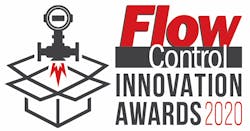
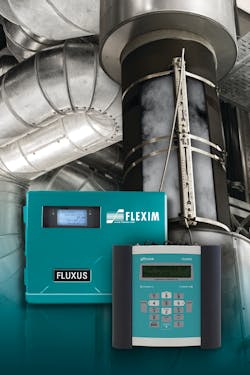
![Flexim 20200721 144553[1] Flexim 20200721 144553[1]](https://img.piprocessinstrumentation.com/files/base/ebm/fcn/image/2020/09/20200721_144553_1_.5f5a9d6a5e33b.png?auto=format,compress&fit=max&q=45&w=250&width=250)
